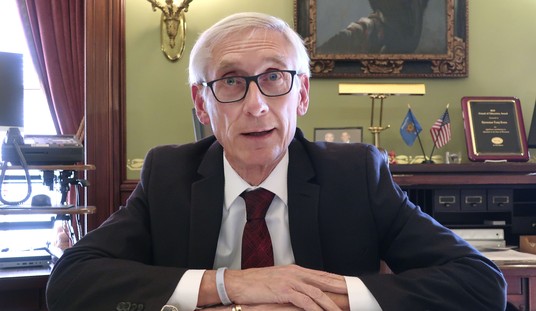Let me begin with a caveat and a confession. This post is above my pay grade. I just learned yesterday that such a thing as “split flow effects of the Big Island” exist, and I have only the vaguest idea of what that phrase means. (Something about how the Big Island’s massive mountains disrupt air flows and storm structures in a manner that the Atlantic basin’s biggest mountains, on Hispaniola, can only dream of.) So I’m speculating here, and I could well be wrong. But man, look at this visible satellite loop:

A few things. First, the bright diagonal line that sweeps across the image at the beginning represents the transition from infrared imagery (before sunrise) and visible imagery (after sunrise).
Second, Flossie’s low-level center of circulation — which is what defines the storm’s official “location” — is that spinning swirl of scattered-ish looking clouds (in the visible images), rotating counterclockwise. During the course of the GIF, it moves from NE of the Big Island to NW of Big Island to near Maui.
And third, Flossie’s thunderstorms or “convection” — i.e., where most of the rain is happening; the part of the storm that actually feels like a storm — is the big blob of solid white cloud that seems to be moving straight toward the Big Island, before diving SW.
Now that you’ve oriented yourself, what do you notice? I’ll tell you what I notice: it kinda looks like the Big Island of Hawaii has cut Tropical Storm Flossie in half with a giant pair of atmospheric scissors. The low-level circulation center got separated, or “decoupled,” from the convection overnight, and this morning, the two started moving in drastically different directions, with the center staying well away from the Big Island and heading to Maui (likely with minimal rain), while the big blob of convection wobbled south, almost stalled, and finally slammed into the Big Island.
Technically, this arguably means that Flossie is no longer really a tropical cyclone, although the Central Pacific Hurricane Center (CPHC) is keeping advisories going anyway…like they should have done once Hurricane Sandy technically ceased to be tropical…but I digress. Back to the decoupling and divergence of low-level center and mid/high-level convection. You see this sort of thing all the time when tropical storms are getting torn apart by upper-level wind shear, but it rarely looks quite this dramatic, distinct or sudden. Or maybe it does, and I just don’t typically notice because there isn’t the visual cue of an island in the middle of everything to make it look so interesting. Perhaps the Big Island’s presence there is just a coincidence, and this is all purely the result of regular ol’ wind shear, and the same thing would have happened regardless of Mauna Kea and Mauna Loa. But I wonder.
Meteorologists are always quick to point out, and rightfully so, that the notion of any land mass reliably “deflecting” tropical cyclones is a dangerous, complacency-inducing urban legend — storms can and do make landfall anywhere in their path. At the same time, though, the Central Pacific Hurricane Center did write this last night:
SLIGHTLY STRONGER NORTHERLY FLOW ALOFT WEST OF THE COL MAY ACCOUNT FOR THE SMALL SOUTHERLY TRACK COMPONENT AND LOSS OF LATITUDE. ANOTHER POSSIBILITY IS THAT FLOSSIE IS BEGINNING TO FEEL THE SPLIT FLOW EFFECTS OF THE BIG ISLAND…AT LEAST ALONG ITS WESTERN PERIPHERY. … TRACK GUIDANCE REMAINS TIGHTLY CLUSTERED IN THE SHORT TERM…SHOWING FLOSSIE NEAR THE BIG ISLAND AND MAUI MONDAY MORNING…THEN PASSING SOUTH OF OAHU MONDAY NIGHT AND SOUTH OF KAUAI THROUGH TUESDAY. … [HOWEVER,] IT IS IMPORTANT TO NOTE THAT FLOSSIE IS VERY LIKELY TO TRACK ACROSS AT LEAST A PORTION OF THE BIG ISLAND OVER THE NEXT 36 HOURS … INTRODUCING THE DIFFICULTY OF ACCOUNTING FOR TERRAIN EFFECTS ON SYSTEM TRACK AND INTENSITY. POST-BIG ISLAND TRACK AND INTENSITY FORECASTS MAY BE QUITE DIFFERENT ONCE THESE TERRAIN EFFECTS ARE KNOWN.
So, I’m not just making this up, I swear!
Anyway, this is all really a meteorological curiosity. In terms of Flossie’s actual impacts… well, they haven’t been too bad just yet, but even as I’ve been composing this post, it looks like things have gotten interesting:
#Flossie woke up! Thunderstorms just EXPLODING to E & SE of the center! Maui could get clocked hard tonight. #hiwx pic.twitter.com/21IAlhglkM
— Robert Ballard (@firebomb56) July 30, 2013
#Flossie #hiwx BIG band of heavy thundershowers extending from Waimea to E of Maui, heading westward! pic.twitter.com/9L14QPEaPI
— Robert Ballard (@firebomb56) July 30, 2013
Radar image of #Flossie: Maui about to get walloped by developing thunderstorm complex. pic.twitter.com/RoEq8rlIWP
— Brendan Loy (@brendanloy) July 30, 2013
Here’s the base velocity radar view of #Flossie, showing some decent winds also headed for Maui with that squall: pic.twitter.com/6kwuqqbxV0
— Brendan Loy (@brendanloy) July 30, 2013
Nothing to #PANIC about, nor a cause for hype. But it’s definitely going to be a dark and stormy afternoon and night in parts of Hawaii. If you’re there, stay safe, don’t take dumb risks, and listen to the advice of local authorities.
That’s all for now. As per usual, follow me on Twitter at @brendanloy for updates and RTs. Also follow Amy Sweezey’s “Wx Tweeps” Twitter list; lots of good weather folks there, updating frequently.









Join the conversation as a VIP Member